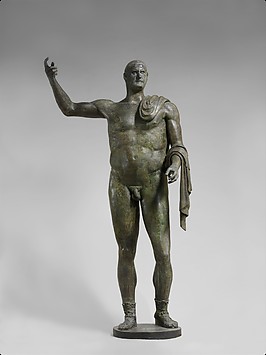Dr. Renee M. Gondek, “Introduction to ancient Greek art,” in Smarthistory, August 14, 2016, accessed December 9, 2018, https://smarthistory.org/greek_intro/.
-This source by Dr. Renee M. Gondek describes an introduction to ancient Green art while going in depth on language, religion, and culture of different time periods. This can be useful for my project and proposed thesis statement because Gondek talks about the introduction of Greek art in the Archaic period with the stand still statue of Kouros.
Dr. Bryan Zygmont, “Hiram Powers, The Greek Slave,” in Smarthistory, January 24, 2018, https://smarthistory.org/hiram-power-greek-slave/.
-This source by Dr. Bryan Zygmont is about the story and origin of the Greek Slave and how it became a well known sculpture. This can be useful for my project because it provides a deep analysis of the sculpture itself as well as Hiram Powers’ (the artist) meaning behind the features of The Greek Slave. Through defining the female nude of the slave, I would be able to further argue my thesis of how Greek and Roman art used the human body to tell a story and symbolize beauty through experience.
Dr. Beth Harris and Dr. Steven Zucker, “Marble statue of a kouros (New York Kouros),” in Smarthistory, December 20, 2015, accessed December 9, 2018, https://smarthistory.org/marble-statue-of-a-kouros-new-york-kouros/.
-This source by Dr. Beth Harris and Dr. Steven Zucker provides two videos on the Kouros itself. This is simply an all about video on the Kouros and what each feature of the stand still sculpture represents. This is helpful for my project because it offers descriptions on the kouros and what the body represents. This relates to my thesis on why the human body was used in Greek and Roman art.
Gisela M. A. Richter. “The Greek Kouros in the Metropolitan Museum of Art.” The Journal of Hellenic Studies, vol. 53, 1933, pp. 51–53. JSTOR, JSTOR, www.jstor.org/stable/627245.
-This scholarly article by Gisela M. A. Richter is about the Kouros in The Metropolitan Museum. This article provides the significance of the statue of Kouros as well as information on the preservation of the Kouros and how it made its way into The Metropolitan Museum. This article is useful because it provides information on the Kouros and what the human body symbolizes in the statue.
Mattingly, Harold. “THE REIGNS OF TREBONIANUS GALLUS AND VOLUSIAN AND OF AEMILIAN.” The Numismatic Chronicle and Journal of the Royal Numismatic Society, vol. 6, no. 1/2, 1946, pp. 36–46. JSTOR, JSTOR, www.jstor.org/stable/42661251.
-This scholarly article by Harold Mattingly is about the reigns of emperor Trebonianus Gallus. This article offers a brief history on the reigns of Trebonianus Gallus. This can be useful for my project because I can use his experiences to describe why the sculpture is the way it is.



